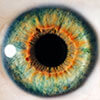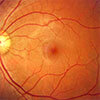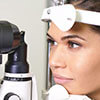2022 arrived on a wave of headlines, and I’m sure we all await a year where COVID isn’t the number one news story. In the midst of our dark winter days, I know some who continue to cope by extending the “happy holiday season” well into the new year. I would like to revisit an interesting case that captures the holiday theme — I call it: The Case of the Christmas Tree… Cataract.
Meet MM. A 72 year old Caucasian female who presented with complaints of deteriorating vision over the past few years. She has the classic cataract complaints of difficulty reading, increased glare when driving, and eye strain (especially when not wearing her glasses). She is currently using Refresh artificial tears to manage her dry eye symptoms. She has a history of LASIK, dry eye syndrome, mild Fuch’s dystrophy, combined cataracts, extramacular drusen, and PVD. You can see her vision statistics, exam findings, and health history below:
| Current glasses Rx | Vision | |
|---|---|---|
| OD | +0.25+0.50×103; ADD +2.50 | 20/40-2 |
| OS | -1.25+0.75×136; ADD +2.50 | 20/40 |
| Anterior segment | Posterior Segment | |
|---|---|---|
| OD | Inspissated glands, mild conjchalasis, LASIK scar, 2+ guttata, 2+ NS with 2+ cortical opacities | Well perfused ONH with C/D 0.45, drusen throughout arcades, PVD |
| OS | Inspissated glands, mild conjchalasis, LASIK scar, 2+ guttata, ?salzmann nodule 9:30, 2+ NS with 2+ cortical opacities and refractile opacity superocentral | Well perfused ONH with C/D 0.35, drusen throughout arcades, PVD |
| Medical history | Medications |
|---|---|
| Arthritis Migraines Liver disease (as a child) Blood clots ASD (hx surgery) Granulomatous polyangitis GERD Depleted hormones |
Vitamin D3, B12 Aspirin 325mg Azathioprine Colchicine (anti-inflammatory drug) Omeprazole HRT/premarin |
A Christmas Tree Cataract (CTC) is a rare lens change often described as polychromatic needle shaped crystals crisscrossing the deep cortex and nucleus of the lens. Due to the refractive, colorful nature of the cataract when observed, it often gives the appearance of colored lights on the branches of a Christmas tree. Most of the time, a CTC is visually non-disturbing and is often monitored until other forms of cataract worsen and cause visually symptomatic effects.
crystals crisscrossing the deep cortex and nucleus of the lens. Due to the refractive, colorful nature of the cataract when observed, it often gives the appearance of colored lights on the branches of a Christmas tree. Most of the time, a CTC is visually non-disturbing and is often monitored until other forms of cataract worsen and cause visually symptomatic effects.
Several postulations exist to describe the formation of a CTC. It has been postulated that the cataract is made of cholesterol crystals and is the result of lens metabolism, that the cataract forms from diffraction of light from parallel sided stacks of fused cell membranes, that the cataract is formed from cysteine crystals and an age-related aberrant breakdown of crystalline induced by elevated calcium levels, or that an accelerated breakdown of membrane associated proteins and excess cysteine concentration leads to crystal growth.1
It is interesting to look at the connection between calcium levels and cataract formation. Hypercalcemia and increased intracellular calcium levels can change the organization of proteins within the membrane gap junctions and affect the ease with which substances can pass from one lens cell to the next. It has been shown that lenses with extremely high calcium concentrations form dense precipitates of calcium salts whereas lenses with moderate calcium concentrations undergo protein aggregation. The ability of calcium to induce cellular uncoupling may explain why many lens opacities involving higher calcium levels are highly localized.2 With this information about calcium and cataract formation combined with the postulations of why a CTC forms, it is plausible to say that any medical disease causing hypercalcemia can increase the risk of developing a Christmas Tree Cataract (as in the case of our patient MM above). Since hypercalcemia can occur in various granulomatous diseases, our patient MM may have developed her unilateral CTC from hypercalcemia in response to her condition of granulomatosis with polyangiitis.
 Finally, it would be rude of me to talk about Christmas Tree Cataracts without mentioning myotonic dystrophy. As most of us remember from school, this type of cataract is often related to myotonic dystrophy and one study notes that myotonic dystrophy is found in 16% of CTC cases. With regards to myotonic dystrophy, a retrospective review of medical records of 23 patients with myotonic dystrophy type 1 (DM1) revealed the presence of CTC in 56% of cases and CTC was found to be unilateral in most cases with a few cases being asymmetrically bilateral. The average age of CTC diagnosis was 35-52 years of age and CTC was found to be the first sign of the disease in nearly half the cases.3 With this knowledge, detection of a Christmas Tree Cataract on routine exam should necessitate a referral for neuromuscular assessment, since nearly half of the patients with DM1 are asymptomatic and a CTC is the first sign of the disease.
Finally, it would be rude of me to talk about Christmas Tree Cataracts without mentioning myotonic dystrophy. As most of us remember from school, this type of cataract is often related to myotonic dystrophy and one study notes that myotonic dystrophy is found in 16% of CTC cases. With regards to myotonic dystrophy, a retrospective review of medical records of 23 patients with myotonic dystrophy type 1 (DM1) revealed the presence of CTC in 56% of cases and CTC was found to be unilateral in most cases with a few cases being asymmetrically bilateral. The average age of CTC diagnosis was 35-52 years of age and CTC was found to be the first sign of the disease in nearly half the cases.3 With this knowledge, detection of a Christmas Tree Cataract on routine exam should necessitate a referral for neuromuscular assessment, since nearly half of the patients with DM1 are asymptomatic and a CTC is the first sign of the disease.
I hope this case served as a little refresher for you all while brightening up your winter days with the beautiful glow of a Christmas Tree Cataract.
References:
- https://www.ncbi.nlm.nih.gov/pmc/articles/PMC4866154/
- https://www.researchgate.net/profile/William-Garner/publication/16627284_Non-Invasive_Techniques_in_the_Study_of_Cataract_Development_at_the_Metabolic_and_Protein_Molecular_Level/links/5bb0f32b299bf13e605854af/Non-Invasive-Techniques-in-the-Study-of-Cataract-Development-at-the-Metabolic-and-Protein-Molecular-Level.pdf#page=142
- https://www.nature.com/articles/s41433-018-0161-9
 Author: Alana N. Curatola, OD
Author: Alana N. Curatola, OD
Specialty: Medical Eye Care
A large part of why I enjoy working at NWES is the opportunity to work directly with our wonderful and amazingly talented surgeons. I enjoy the connections made with our referring community of optometrists and the team work it takes to help care for the eyes of our patients. I enjoy challenging cases that make me think outside the box or delve me into more research.









